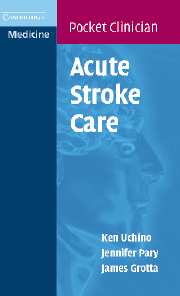Book contents
- Frontmatter
- Contents
- Preface
- List of abbreviations
- 1 Stroke in the emergency department
- 2 What to do first
- 3 Ischemic stroke
- 4 TPA protocol
- 5 Neurological deterioration in acute ischemic stroke
- 6 Ischemic stroke prevention: why we do the things we do
- 7 Transient ischemic attack (TIA)
- 8 Intracerebral hemorrhage (ICH)
- 9 Subarachnoid hemorrhage (SAH)
- 10 Organization of stroke care
- 11 Rehabilitation
- Appendix 1 Numbers and calculations
- Appendix 2 IV TPA dosing chart
- Appendix 3 Sample admission orders
- Appendix 4 Sample discharge summary
- Appendix 5 Stroke radiology
- Appendix 6 Transcranial Doppler ultrasound (TCD)
- Appendix 7 Heparin protocol
- Appendix 8 Insulin protocol
- Appendix 9 Medical complications
- Appendix 10 Brainstem syndromes
- Appendix 11 Cerebral arterial anatomy
- Appendix 12 Stroke in the young and less common stroke diagnoses
- Appendix 13 Brain death criteria
- Appendix 14 Neurological scales
- Recommended reading
- References
2 - What to do first
Published online by Cambridge University Press: 10 October 2009
- Frontmatter
- Contents
- Preface
- List of abbreviations
- 1 Stroke in the emergency department
- 2 What to do first
- 3 Ischemic stroke
- 4 TPA protocol
- 5 Neurological deterioration in acute ischemic stroke
- 6 Ischemic stroke prevention: why we do the things we do
- 7 Transient ischemic attack (TIA)
- 8 Intracerebral hemorrhage (ICH)
- 9 Subarachnoid hemorrhage (SAH)
- 10 Organization of stroke care
- 11 Rehabilitation
- Appendix 1 Numbers and calculations
- Appendix 2 IV TPA dosing chart
- Appendix 3 Sample admission orders
- Appendix 4 Sample discharge summary
- Appendix 5 Stroke radiology
- Appendix 6 Transcranial Doppler ultrasound (TCD)
- Appendix 7 Heparin protocol
- Appendix 8 Insulin protocol
- Appendix 9 Medical complications
- Appendix 10 Brainstem syndromes
- Appendix 11 Cerebral arterial anatomy
- Appendix 12 Stroke in the young and less common stroke diagnoses
- Appendix 13 Brain death criteria
- Appendix 14 Neurological scales
- Recommended reading
- References
Summary
The following initial measures apply to all stroke patients. They are necessary to stabilize and assess the patient, and prepare for definitive therapy. All current and, probably, future stroke therapies for both ischemic and hemorrhagic stroke are best implemented as fast as possible, so these things need to be done quickly. This is the general order to do things, but in reality, in order to speed the process, these measures are usually dealt with simultaneously. They are best addressed in the ED, where urgent care pathways for stroke should be established and part of the routine (see Chapter 10).
Airway – breathing – circulation (ABCs)
O2 via nasal cannula (routine oxygen delivery in ischemia might improve outcome).
Intubation may be necessary if the patient shows arterial oxygen desaturation or cannot “protect” their airway from aspirating secretions. However, intubation means that the ability to monitor the neurological exam is lost. The best approach in such patients is to prepare to intubate immediately, but before doing so, take a moment to be sure the patient does not spontaneously improve or stabilize with good nursing care (suctioning, head position, etc.). Also, if needed, use sedating or paralyzing drugs with a short half-life, to allow for serial neurological exams.
Consider putting the head of the bed flat. This can significantly help cerebral perfusion. The head of the bed may need to be elevated if airway protection and continued nausea and vomiting are concerns for those with obtundation, nausea, severe dysphagia, or aspiration risk.
Consider normal saline bolus 250–500 cc if blood pressure is low.
[…]
- Type
- Chapter
- Information
- Acute Stroke CareA Manual from the University of Texas - Houston Stroke Team, pp. 8 - 12Publisher: Cambridge University PressPrint publication year: 2007



